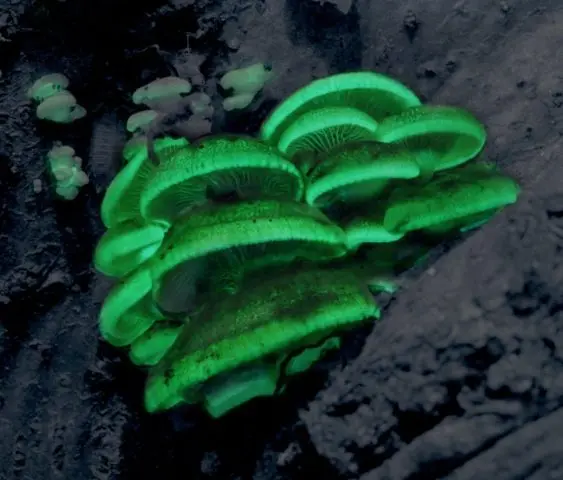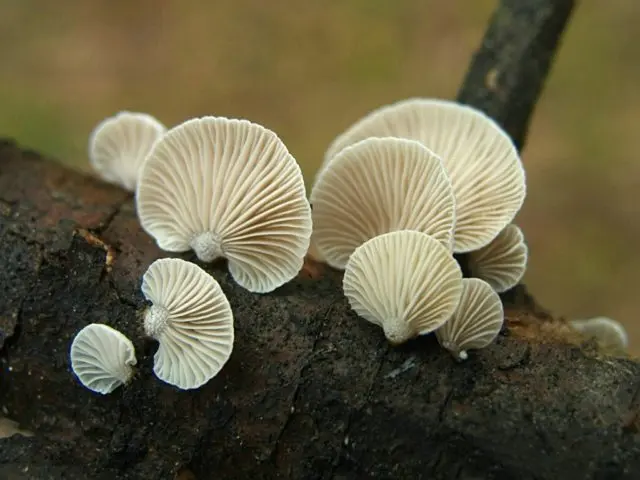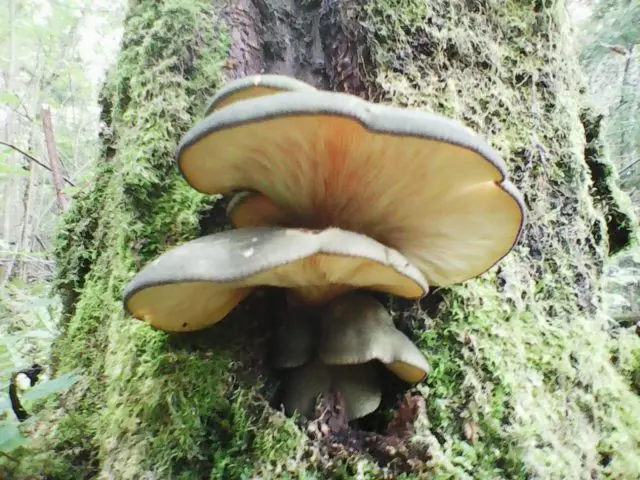Contents
Astringent panellus – at first glance, an unremarkable mushroom, if you do not know about its interesting feature – the ability to glow in the dark. Many mushroom pickers have repeatedly seen entire colonies of panellus, sticking around rotten stumps or fallen trees, but did not suspect what metamorphoses occur with the onset of night.
What does panellus astringent look like?
Panellus astringent (Panellus stipticus) is an agaric mushroom of the Mycenaceae family. The fruiting body consists of a low stem and a fan-shaped cap.

At a young age, the cap is kidney-shaped, but as it develops, it acquires a depressed shape with tucked lobed or wavy edges, resembling an auricle. In a humid environment, the color of the cap is yellow-brown or clayey, when it dries it becomes light ocher. In rare cases, astringent panellus may have an almost white tint. The diameter of the cap does not exceed 2-4 cm, its surface is matte, strewn with grains and covered with small cracks.
The reverse side of the cap is represented by narrow thin plates located close to each other, sometimes branched or soldered in some places with bridges. Their color is identical to the hat, closer to the place of growth, the shade is more saturated. The spore powder is white, the spores themselves are oblong and bean-shaped.
The leg is on the side. Weakly developed. Height – from 1 to 10 mm, with a diameter of 2-7 mm. The shape of the stem is cylindrical, often tapering at the base, without cavities inside. The upper part has pubescence. The color matches the hat or a little lighter.
The pulp of the astringent panellus is cream or ocher in color. The structure is leathery, elastic. The mushroom has a distinct smell. The taste of the pulp is astringent, slightly caustic and bitter.
Why does panellus astringent glow in the dark?
Panellus astringent is one of the few living organisms capable of bioluminescence. Other representatives of the kingdom of fungi glow due to bacteria that have settled on their surface. But the astringent panellus emits light due to its own enzyme – luciferase. When interacting with oxygen, the luciferin pigment oxidizes and begins to shine with a cold green glow. Mature specimens glow most brightly during spore maturation. The intensity is enough not to use a slow shutter speed when photographing.

Where and how to grow
Mushrooms of the species panellus astringent are common in North America, Eurasia. Australia. On the territory of the Federation can be found in almost the entire forest zone. This luminiferous mushroom is not uncommon for regions such as:
- Siberia;
- Primorye;
- Caucasus.
Panellus astringent prefers to settle on rotten wood, most often on stumps and fallen trunks of deciduous trees. Especially loves oak, beech, birch. It grows in numerous groups, sometimes completely sticking around the stumps. The main fruiting period is from the first half of August until late autumn, in some places the species can also be found in spring. Fruiting bodies do not rot, but simply dry out. Often you can observe entire colonies of last year’s mushrooms, fused at the base.
Is the mushroom edible or not?
This representative belongs to the category of inedible mushrooms. Forest fruits are not used for food, in any form. Some sources have information about edibility after heat treatment, however, it is better to refrain from eating them and not risk your health.
Twins and their differences
Astringent panellus can be confused with soft panellus (Panellus mitis). The species is distinguished by a lighter, almost white color, in young mushrooms the cap is sticky. An inedible double settles on fallen branches of coniferous trees, most often on Christmas trees.

The conditionally edible autumn oyster mushroom (Panellus serotinus) is very similar to the astringent panellus. It is distinguished by a gray-brown or green-brown cap, which is covered with a thin layer of mucus.

Conclusion
Panellus astringent is an interesting mushroom to observe and study. Few people manage to see it in all its glory, because at night you can only find yourself in the forest by accident. Looking at the greenish mushrooms shining in the dark, you can once again see how diverse and amazing nature is.









